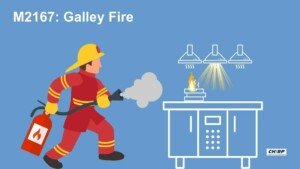The Charity
Aviation
Maritime
M2167

Initial Report
As a chef was leaving the galley area, having closed it down after the meal, they noticed smoke seeping from a door in a smaller, less frequently used section of the galley. Concerned, the chef investigated and found that several pizza boxes had caught fire. These had been stored under heating lamps, which, unknown to anyone, had been inadvertently switched on during the cleaning process. Acting promptly, the chef immediately reported the fire to the bridge using the radio communication system, then turned off the heating lamps and retreated to a safe distance near the doorway.
Responding swiftly, the duty deckhand arrived at the scene without delay. Their initial attempt to suppress the fire using the high fog system was met with challenges due to the fire’s growing intensity. Meanwhile, another chef joined the effort, moving the burning pizza boxes away from other items to contain the fire’s spread. With the escalating situation, the duty deckhand used a foam extinguisher to effectively put out the flames on the pizza boxes and the area surrounding the heating lamps.
Additional crewmembers quickly arrived and took decisive emergency measures, shutting down all electrical systems and ventilation in the galley to prevent the heat from the fire from spreading. Simultaneously, nearby doors were promptly closed to curtail the spread of smoke to other parts of the ship.
The ship’s engineers discussed the manual operation of the ventilation system from the engine control room (ECR), aiming to extract the lingering smoke from the galley area efficiently.
From the moment the fire was reported to the bridge, the containment and control of the fire took approximately six minutes.
CHIRP Comment
CHIRP praises the crew and the management for having a well-trained crew which handled a potentially dangerous situation swiftly. However, there are a couple of points worth highlighting. The bridge was notified by radio and responded to the incident. Anyone discovering a fire should always raise a loud vocal alarm (eg shouting ‘Fire, Fire, Fire’), and the fire alarm, if fitted, should always be sounded. Both of these alert everyone in the vicinity that there is a fire so that they can assist in tackling it. The ventilation should be stopped if not done automatically. The use of high-fog as an extinguishing medium was ineffective and, in this case, raises the question of whether it is the right application for a fire that has taken hold.
Heat energy transference from an energy light source can be extremely high, and direct contact is not necessary to start a fire. Materials such as cardboard and plastic coverings will quickly smoulder or melt, even in close contact with normal shipboard lighting sources. A minimum distance warning sign should be positioned near any heat lamp so that flammable material cannot be heated to combustion, or a suitable guard should be placed around the lamp to provide a physical barrier that meets the minimum safe distance if applicable.
Light switches should be properly labelled and positioned in sensible locations close to the storerooms they serve. They should also be clearly labelled. If in doubt, ask the electrical officer to check the function of the switch in question.
Storage of any material should always be considered from the point of view of fire risk and how to control that risk. Eliminating the hazard is the best way to reduce risk. If, after the debrief for this incident, the heating lamps are found to serve no operational function, consideration should be given to isolating the circuit. Hence, they become non-operational and labelled as such.
The incident underscores the importance of crew members’ vigilance and highlights effective teamwork and everyone’s critical role in ensuring the ship’s and its occupants’ safety and security. Different crew members’ collaborative and swift actions – from the chef’s initial discovery to the coordinated response efforts – ultimately contained and extinguished the fire.
The ISM Code Section 8, Emergency Preparedness, mandates regular exercises and drills for emergencies. This concise response highlights its value, and whilst there were areas for improvement, the crew contained and extinguished the fire. It is a valuable lesson for maritime safety and emphasises the importance of continuous training and preparedness.
Key Issues relating to this report
Situational awareness – The crew’s response to the emergency was swift and appropriate. There needed to be more awareness of the switch’s function (controlling the heat lamp) by the crew. It was very likely that the heat lamps had been switched on before with no consequence. However, this time, pizza boxes were stored near the lamps and combusted due to radiated heat from the lamps.
Communication – This switching arrangement was likely similar in other ships of the same class. Communicating the possible hazards to other ships of the same type by labelling the switch and providing safeguards for preventing contact with flammable materials is required. How does your company communicate design hazards?
Design – Better design at the new building stages, providing built-in safeguards for heat contact and switches in the same room, as the lamps would help prevent accidental use.
This data type is not supported! Please contact the author for help.






